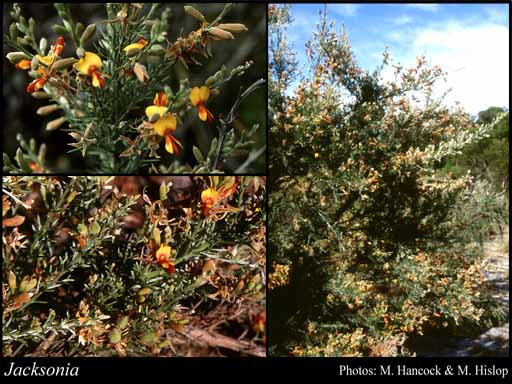- Reference
- Cycl. 18 (1811)
- Name Status
- Current







Scientific Description
Family Papilionaceae. Mirbelieae.
Sometimes included in Leguminosae.
Habit and leaf form. Shrubs. Switch-plants (with or without phylloclades); with the principal photosynthesizing function transferred to stems. Leaves much reduced (save in seedlings). Plants spiny, or unarmed. The spines when present, axial. To 0.1–5 m high. Xerophytic. Cladodes flattened, or semiterete, or terete, or solid/angular; unarmed, or spine-tipped, or modified into spines. Leaves or rather, scales, alternate; without stipules.
Reproductive type, pollination. Fertile flowers hermaphrodite. Unisexual flowers absent. Plants hermaphrodite. Entomophilous.
Inflorescence and flower features. Flowers solitary (rarely), or aggregated in ‘inflorescences’; not crowded at the stem bases; when solitary, axillary (i.e., to scales); when aggregated, in racemes, or in spikes. The terminal inflorescence unit racemose. Inflorescences terminal, or axillary (or at least, ‘lateral’ — axillary to scales); terminal or lateral racemes or spikes, or flowers scattered on the branchlets. Flowers pedicellate, or subsessile; usually bracteate (the bracts minute); bracteolate (the bracteoles small). Bracteoles persistent, or deciduous. Flowers very irregular; zygomorphic. The floral asymmetry involving the perianth, or involving the perianth and involving the androecium. Flowers papilionaceous; tetracyclic. Floral receptacle developing a gynophore, or with neither androphore nor gynophore. Free hypanthium present, or absent. Hypogynous disk present; intrastaminal; annular. Perianth with distinct calyx and corolla; 10; 2 -whorled; isomerous. Calyx present; 5; 1 -whorled; gamosepalous; lobed. Calyx lobes markedly longer than the tube (the tube short). Calyx valvate; somewhat exceeded by the corolla, or more or less equalling the corolla, or exceeding the corolla; bilabiate, or regular (the upper pair of members usually broader, rarely more joined); non-fleshy; persistent; non-accrescent; with the median member anterior. Corolla present; 5; 1 -whorled; appendiculate, or not appendiculate. Standard not appendaged. Corolla partially gamopetalous. 2 of the petals joined. The joined petals anterior. The wings of the corolla free from the keel (the keel members); not laterally spurred. Standard ‘normally’ developed; emarginate. Keel conspicuously exceeded by the wings, or about equalling the wings, or conspicuously exceeding the wings; not long-acuminate/beaked; neither coiled nor spiralled; not bent and beaked. Corolla imbricate; yellow, or yellow and purple (the keel usually darker); not fleshy; deciduous. Petals clawed to sessile (subsessile). Androecial members definite in number. Androecium 10. Androecial sequence determinable, or not determinable. Androecial members free of the perianth; all equal to markedly unequal; free of one another; 1 -whorled. Androecium exclusively of fertile stamens. Stamens 10; all more or less similar in shape; diplostemonous; both opposite and alternating with the corolla members; filantherous. Anthers separate from one another to connivent; all alike; dorsifixed; versatile; dehiscing via longitudinal slits; latrorse, or introrse; tetrasporangiate. Gynoecium 1 carpelled. The pistil 1 celled. Carpels reduced in number relative to the perianth. Gynoecium monomerous; of one carpel; superior. Carpel stylate. Style (in-) curved (subulate). Style hairy but not bearded, or glabrous. Stigmatic tissue terminal. Carpel usually 2 ovuled. Placentation marginal. Ovary sessile to stipitate. Stigmas punctiform (minute). Ovules shortly funicled; biseriate.
Fruit and seed features. Fruit stipitate to sessile; non-fleshy. The fruiting carpel dehiscent; a legume. Pods globose to much elongated; not triangular; straight; becoming inflated, or not becoming inflated; more or less flat to terete; not constricted between the seeds; not transversely septate; wingless. Fruit 1 celled. Dispersal unit the seed. Fruit 1–2 seeded (elipsoid, with an enlarged radicular lobe). Seeds not mucous; arillate, or non-arillate. Embryo bent (radicle inflexed). Testa non-operculate; conspicuously colour-patterned (usually mottled or striped).
Geography, cytology, number of species. Native of Australia. 2n = 18. A genus of about 50 species; about 67 species in Western Australia.
Taxonomic Literature
- Wheeler, Judy; Marchant, Neville; Lewington, Margaret; Graham, Lorraine 2002. Flora of the south west, Bunbury, Augusta, Denmark. Volume 2, dicotyledons. Australian Biological Resources Study.. Canberra..
- Grieve, B. J.; Blackall, W. E. 1998. How to know Western Australian wildflowers : a key to the flora of the extratropical regions of Western Australia. Part II, Dicotyledons (Amaranthaceae to Lythraceae). University of W.A. Press.. Nedlands, W.A..
- Wheeler, J. R.; Rye, B. L.; Koch, B. L.; Wilson, A. J. G.; Western Australian Herbarium 1992. Flora of the Kimberley region. Western Australian Herbarium.. Como, W.A..
- Marchant, N. G.; Wheeler, J. R.; Rye, B. L.; Bennett, E. M.; Lander, N. S.; Macfarlane, T. D.; Western Australian Herbarium 1987. Flora of the Perth region. Part one. Western Australian Herbarium.. [Perth]..